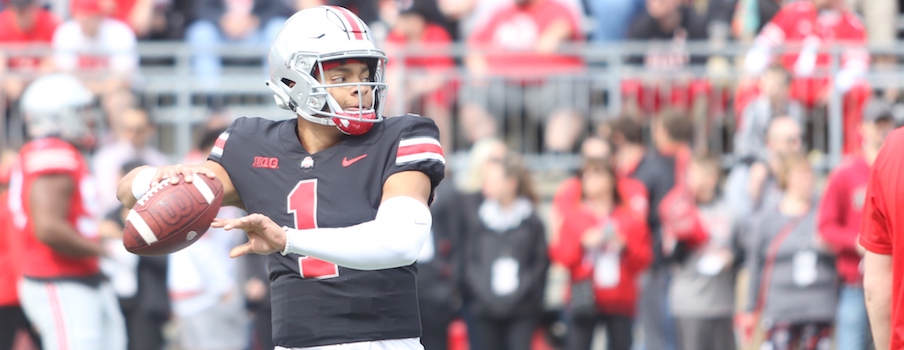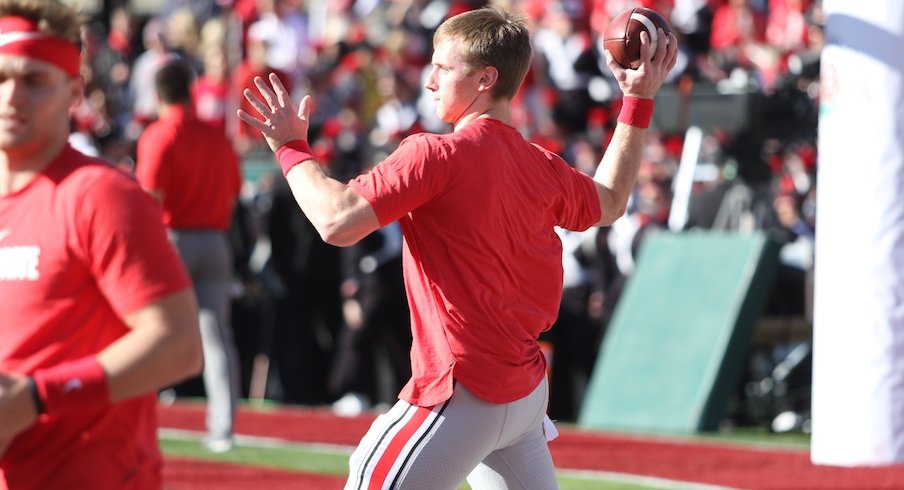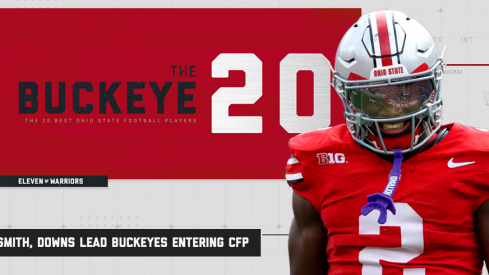Ohio State head coach Ryan Day has said that he ideally wants the Buckeyes to have four scholarship quarterbacks at all times.
Maintaining that number of scholarship quarterbacks is becoming an increasingly difficult task.
Ohio State is currently down to just two scholarship quarterbacks for the 2019 season after Tate Martell transferred to Miami in January and Matthew Baldwin entered the transfer portal on Thursday, later confirming in a statement on Twitter that he is stepping away from the program.
If you’re an Ohio State fan, you might be thinking, ‘What’s happening here?’ Ohio State has now lost three scholarship quarterbacks to transfers in a year’s time – Joe Burrow went to LSU as a graduate transfer after Dwayne Haskins beat him out for the starting job last spring – while Haskins left to enter the NFL draft after just one year as a starter.
That said, frequent turnover at the quarterback position is increasingly becoming the new normal in college football, not only at Ohio State but at other major programs as well.
Clemson was down to just two quarterbacks who were recruited as scholarship players when it won the national championship last season. Alabama lost its backup quarterback Jalen Hurts in a graduate transfer to Oklahoma, which added Hurts but lost the quarterback who would have been his backup, Austin Kendall, who chose to transfer to West Virginia even after Kyler Murray declared for the NFL draft. Georgia is down to three scholarship quarterbacks, one of who previously transferred out of the program (Stetson Bennett) and one who flipped from Ohio State on early signing day (Dwan Mathis), after losing Justin Fields to Ohio State.
Now that the transfer portal has made it easier than ever for college football players to transfer elsewhere, and waivers for immediate eligibility have become more commonplace too, it’s become a regular occurrence for backup quarterbacks to change schools in search of starting opportunities that could come sooner.
More examples from this offseason alone:
- Former Clemson quarterback Kelly Bryant and TCU quarterback Shawn Robinson both transferred to Missouri
- Notre Dame quarterback Brandon Wimbush, who lost the starting job last season to Ian Book, transferred to UCF
- Texas backup quarterbacks Shane Buechele and Cameron Rising transferred to SMU and Utah
- Texas A&M quarterback Nick Starkel transferred to Arkansas
- Penn State quarterback Tommy Stevens entered the transfer portal on Wednesday after Sean Clifford emerged as the frontrunner to start
At a position where only one player typically sees significant playing time for each team, talented quarterbacks who believe they can start at other schools are more empowered than ever to seek out those opportunities, and teams like Ohio State must now adjust accordingly.
Ohio State’s current situation is especially stark because it now has only two scholarship quarterbacks, and one of those quarterbacks – Chris Chugunov – is a graduate transfer who was brought in last summer with no expectations of ever becoming the Buckeyes' starter.
The Buckeyes are in this situation because they have lost five quarterbacks who could have been on their roster this year, which certainly is a huge number, though only a couple of those departures actually came by surprise. Burrow was expected to transfer if he lost last spring’s starting quarterback competition to Haskins, who quickly emerged as a candidate to enter this year’s NFL draft with his play last fall. Martell’s departure was foreseeable after Fields’ arrival.
What really hurt the Buckeyes’ quarterback depth for this season was Mathis’ last-minute flip, which left them without any favorable options for the 2019 recruiting class, and Baldwin’s departure, which comes as a surprise even though Fields – who comes to Ohio State at the expense of Georgia’s quarterback depth – was the frontrunner to start at quarterback all along.
Each of those players made their respective decisions for their own individual reasons, so their collective departures shouldn’t necessarily be seen as an indictment on Ohio State or Day – who, of course, has only been the Buckeyes’ head coach for about four months. By luring Fields to come to Ohio State just weeks after becoming the Buckeyes’ head coach, Day demonstrated that his program should continue to attract interest from some of the top quarterbacks in the country.
The Buckeyes have a longstanding and unwavering commitment from Jack Miller, the No. 4-ranked pro-style quarterback in the class of 2020, who is the early frontrunner to become Ohio State’s next starting quarterback in 2021, when Fields will be eligible to enter the NFL draft.
If Fields and Miller both live up to their potential, Ohio State’s starting quarterback position could be in good hands for at least the next four years.
What Day and the Buckeyes have to do now, though, is find a way to navigate the new transfer-heavy climate at the quarterback position in order to maintain adequate depth. Because while Fields has the potential to be one of the best quarterbacks in college football – and could prove to be well worth the cumulative losses of Mathis, Martell and Baldwin – the Buckeyes are now forced to put all their eggs in one basket, leaving them in a position where an injury to Fields would be catastrophic.

How can the Buckeyes avoid falling back into this position again? That’s a question without a simple answer. Ohio State will continue to target some of the top quarterbacks in the country in every recruiting class, and it should. But those quarterbacks will likely also be inclined to transfer if their opportunity to start doesn’t come when they think it should.
That leaves Ohio State, and other programs of its caliber, with a tougher question to ask themselves: Do they make a concerted effort to recruit some quarterbacks who they believe will be loyal regardless of playing time, even if that means settling for less heralded talent, or do they continue recruiting as many quarterbacks as they can with star potential, and hope for the best?
No matter who the Buckeyes recruit, there’s a chance that player could ultimately become dissatisfied with his standing the program and choose to transfer, so the notion of recruiting quarterbacks who are more likely to stick around is much easier said than done.
If that doesn’t happen, though, a dangerously thin quarterback depth chart could become a recurring problem – and that’s certainly not what Day wants for Ohio State, even though he has acknowledged that it won’t always be possible to have as many scholarship quarterbacks on the roster as he wants.
“You'd like to have four in today's day and age. When you look around the country, not too many teams have four quality quarterbacks on their roster,” Day said on National Signing Day. “You have to adjust with what you have.”
For an example of how quarterback depth can make or break a season, one only needs to look back to Ohio State’s 2014 season, when Braxton Miller and J.T. Barrett both went down with injuries yet the Buckeyes still won a national championship with third-string quarterback Cardale Jones waiting in the wings.
That was already a rare scenario then, however, and it’s likely to be an even rarer scenario now. College football teams can no longer count on talented backup quarterbacks waiting their turn to potentially start in the future, but must prepare for the possibility that any quarterback who is in not line to start could choose to immediately explore his options instead.


